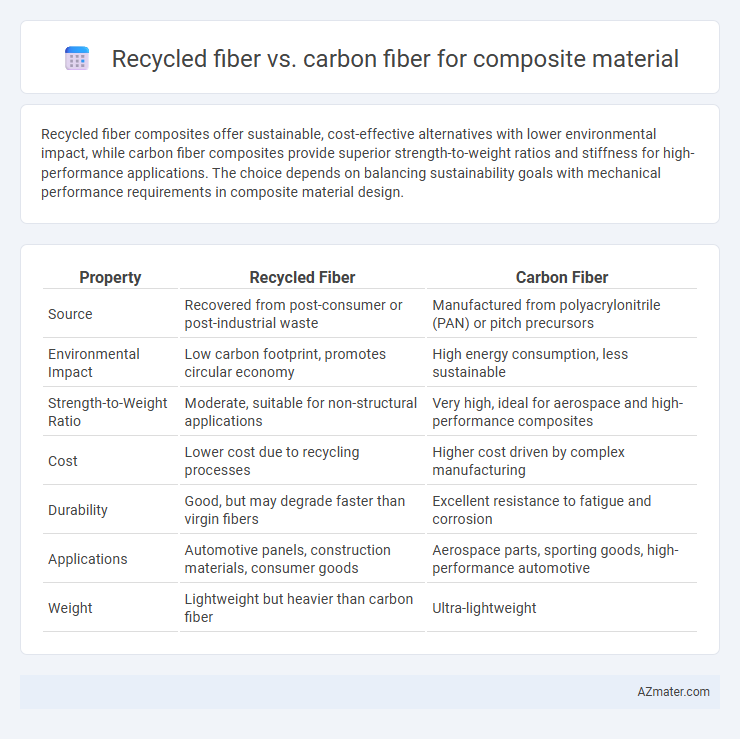Recycled fiber composites offer sustainable, cost-effective alternatives with lower environmental impact, while carbon fiber composites provide superior strength-to-weight ratios and stiffness for high-performance applications. The choice depends on balancing sustainability goals with mechanical performance requirements in composite material design.
Table of Comparison
| Property | Recycled Fiber | Carbon Fiber |
|---|---|---|
| Source | Recovered from post-consumer or post-industrial waste | Manufactured from polyacrylonitrile (PAN) or pitch precursors |
| Environmental Impact | Low carbon footprint, promotes circular economy | High energy consumption, less sustainable |
| Strength-to-Weight Ratio | Moderate, suitable for non-structural applications | Very high, ideal for aerospace and high-performance composites |
| Cost | Lower cost due to recycling processes | Higher cost driven by complex manufacturing |
| Durability | Good, but may degrade faster than virgin fibers | Excellent resistance to fatigue and corrosion |
| Applications | Automotive panels, construction materials, consumer goods | Aerospace parts, sporting goods, high-performance automotive |
| Weight | Lightweight but heavier than carbon fiber | Ultra-lightweight |
Introduction to Composite Materials
Composite materials combine two or more distinct substances to achieve superior mechanical properties, with recycled fiber and carbon fiber being key reinforcements. Recycled fibers, often sourced from post-consumer waste like PET or natural fibers, offer sustainability benefits and reduced environmental impact but generally have lower strength and stiffness than carbon fibers. Carbon fiber composites exhibit exceptional strength-to-weight ratio, high stiffness, and durability, making them ideal for aerospace, automotive, and sporting goods applications where performance is critical.
Overview of Recycled Fiber Composites
Recycled fiber composites are engineered using fibers recovered from post-consumer or industrial waste, offering a sustainable alternative to virgin materials by reducing environmental impact and conserving resources. These composites maintain competitive mechanical properties such as tensile strength and stiffness, making them suitable for automotive, construction, and consumer goods industries. Advances in processing techniques and fiber treatment enhance the compatibility and durability of recycled fibers within polymer matrices, driving increased adoption in eco-conscious manufacturing.
Carbon Fiber: Properties and Applications
Carbon fiber offers exceptional tensile strength, lightweight properties, and high stiffness, making it ideal for aerospace, automotive, and sporting goods applications. Unlike recycled fiber composites, carbon fiber exhibits superior fatigue resistance and thermal stability, enhancing performance in high-stress environments. Its ability to maintain structural integrity under extreme conditions drives its extensive use in advanced engineering and high-performance products.
Mechanical Strength: Recycled vs Carbon Fiber
Recycled fiber composites generally exhibit lower mechanical strength compared to carbon fiber composites, with tensile strengths typically ranging from 150 to 400 MPa versus carbon fiber's 3,500 to 6,000 MPa. Carbon fiber offers superior stiffness and fatigue resistance, making it optimal for high-performance aerospace and automotive applications. While recycled fibers provide environmental benefits and cost-effectiveness, their mechanical properties limit their use in structural components requiring high load-bearing capacity.
Environmental Impact and Sustainability
Recycled fiber composites significantly reduce landfill waste and lower carbon emissions compared to traditional carbon fiber materials, contributing to a smaller environmental footprint. While carbon fiber offers superior strength-to-weight ratios, its production involves high energy consumption and non-renewable resources, challenging sustainability goals. Prioritizing recycled fibers in composite manufacturing promotes circular economy principles by minimizing resource extraction and enhancing material reuse.
Cost Comparison and Economic Feasibility
Recycled fiber composites offer significant cost advantages over carbon fiber counterparts, primarily due to lower raw material expenses and reduced energy consumption during production. Carbon fiber composites, while delivering superior strength-to-weight ratios, carry higher initial costs linked to expensive precursor materials and complex manufacturing processes. Economic feasibility favors recycled fiber composites in large-scale, cost-sensitive applications where performance demands are moderate, whereas carbon fiber remains economically viable for high-performance, lightweight critical structures despite its premium pricing.
Processing Techniques and Challenges
Recycled fiber in composite materials requires careful sorting, cleaning, and reprocessing to maintain fiber integrity, often involving mechanical shredding or chemical treatments that can degrade fiber quality. Carbon fiber composites demand high-temperature curing and precise resin infusion techniques such as autoclaving or resin transfer molding to achieve optimal strength and stiffness, but these methods are energy-intensive and costly. Challenges with recycled fibers include reduced mechanical performance and inconsistent fiber length, while carbon fiber processing struggles with high production costs and environmental impact from energy consumption.
Durability and Lifecycle Performance
Recycled fiber composites offer enhanced durability through resistance to environmental degradation and reduced fatigue, making them suitable for sustainable applications. Carbon fiber composites provide superior strength-to-weight ratios and exceptional fatigue resistance, resulting in longer lifecycle performance in high-stress environments. Lifecycle analysis shows recycled fibers reduce environmental impact but may have slightly lower mechanical endurance compared to carbon fiber, balancing sustainability and performance.
Industry Use Cases and Trends
Recycled fiber composites are increasingly utilized in automotive and construction industries due to their sustainability advantages and cost-effectiveness, while carbon fiber composites dominate aerospace and high-performance sports sectors because of superior strength-to-weight ratios. Emerging trends show growing adoption of recycled fiber in mass-produced consumer goods and automotive interiors, driven by circular economy initiatives and regulatory pressure for reduced carbon footprints. Industry use cases highlight carbon fiber's preference for structural components requiring high stiffness and durability, whereas recycled fiber fits applications prioritizing environmental impact reduction without critical performance trade-offs.
Future Prospects and Innovations
Recycled fiber composites are gaining momentum due to increasing environmental regulations and demand for sustainable materials, with innovations in fiber recovery and enhanced processing techniques improving mechanical properties and cost-efficiency. Carbon fiber composites continue to dominate high-performance sectors such as aerospace and automotive, where advancements in low-cost manufacturing methods and hybrid composites enhance strength-to-weight ratios and durability. Future prospects for both materials involve integrating smart technologies like self-healing and sensing capabilities, driving a new era of high-performance, eco-friendly composite solutions.

Infographic: Recycled fiber vs Carbon fiber for Composite material
 azmater.com
azmater.com